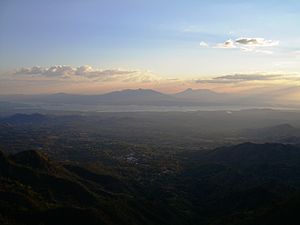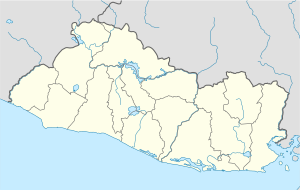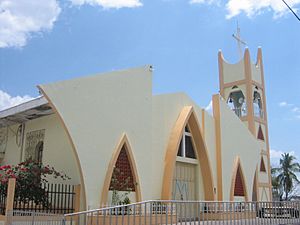Dulce Nombre de María facts for kids
Quick facts for kids
Dulce Nombre de María
|
|
|---|---|
|
Municipality
|
|
 |
|
| Country | |
| Department | Chalatenango Department |
| Area | |
| • Total | 21 sq mi (54 km2) |
| Elevation | 1,266 ft (386 m) |
| Population
(2006)
|
|
| • Total | 8,987 |
Dulce Nombre de María is a small town and municipality in El Salvador. It is part of the Chalatenango Department. The town is about 72 kilometers (45 miles) away from San Salvador, which is the capital city of El Salvador.
This town shares its borders with other places. To the north, you'll find San Fernando. To the south, it's next to San Rafael and Santa Rita. On the east side is Comalapa, and to the west is San Francisco Morazán.
Contents
A Look at Its Past
Dulce Nombre de María was started in 1790. It was founded by several Spanish families. These families were sent by Baron Carandelet, who was a general captain of Guatemala's Kingdom at that time.
The town officially became a village on April 21, 1910. Later, on July 15, 1919, it became an official district of Chalatenango. This means it became a recognized part of the larger Chalatenango area.
The town has a famous church called the Iglesia de Dulce Nombre de María. One of the church bells has a special message written on it. It says "White NS Dulce Nombre de María, 1827." This shows the bell was made in 1827 and dedicated to Dulce Nombre de María. Leon Ventura was the priest when this was written.
Over the years, Dulce Nombre de María has been part of different departments in El Salvador.
- From June 12, 1824, to May 22, 1835, it belonged to the San Salvador department.
- Then, from May 22, 1835, to February 14, 1855, it was part of the Cuscatlán department.
- Since February 14, 1855, Dulce Nombre de María has been a part of the Chalatenango Department.
How the Town is Organized
Dulce Nombre de María is divided into smaller areas called cantones. There are 10 main cantones. These cantones are further divided into 35 caserios, which are like small villages or hamlets.
Here are the main cantones and some of their caserios:
- Cuevitas
- Cuevitas
- Plan Grande
- El Cerro Verde
- Chorro Blanco
- Chorro Blanco
- El Jocote
- El Plan
- El Zángano
- El Camotal
- El Común
- El Común
- El Naranjo
- Las Alas
- El Ocotal
- Plan del Ojo de Agua
- El Chupadero
- El Plan Chino
- El Quebracho
- Cueva del Ermitaño
- Los Pitos
- El Manzano
- El Rosario
- El Rosario
- La Laguna
- Gutiérrez
- Gutiérrez
- La Quinta
- Cerrito de Piedra
- Los Achiotes
- Los Achiotes
- La Cumbre
- El Terrero
- Los Gonzáles
- Los Encuentros
- Los Encuentros
- El Chupadero
- El Calero
- La Mantequilla
- La Chacra
- Sitio Arriba
- Sitio Arriba
- Sitio Abajo
- Sitio Abajo
Beliefs and Community
In Dulce Nombre de María, people follow different religions. The two main religions are Catholicism and Protestantism. Catholicism is the most common religion in the town. Many people attend Catholic services, especially on Sundays.
Exploring the Neighborhoods
The main part of Dulce Nombre de María is divided into five different neighborhoods, also known as barrios. Each barrio has its own special character and traditions.
Concepción Neighborhood
This neighborhood is located in the southern part of the town. It is named after the Virgin of the Immaculate Conception. People celebrate a special holiday for this Virgin on December 8 each year. The Francisco Gavidia School is also located in this neighborhood.
El Calvario Neighborhood
You can find El Calvario in the western part of the town. This barrio is dedicated to Our Lady of Guadalupe. Some Protestant churches, like "El Principe de Paz," are located here. The people in this neighborhood celebrate their special holiday on December 7 every year.
El Carmen Neighborhood
El Carmen is located on the eastern side of the town. This barrio is dedicated to Our Lady of Carmen. The Instituto Nacional de Dulce Nombre de María, which is a national institute, is found here. This neighborhood celebrates its holiday on December 9 each year.
El Centro Neighborhood
As its name suggests, El Centro is in the very heart of the town. This neighborhood is dedicated to Our Lady of Dulce Nombre de María. The main Catholic Church of the town is located in El Centro. The entire town celebrates its main holiday on December 11 each year, which is also dedicated to Our Lady of Dulce Nombre de María.
San José Neighborhood
The San José neighborhood is located in the northern part of the town. It is dedicated to Saint Joseph. This might be the largest neighborhood in the town. It continues to grow towards the north. This barrio celebrates its holiday on December 10 each year.
See Also
 In Spanish: Dulce Nombre de María para niños
In Spanish: Dulce Nombre de María para niños



